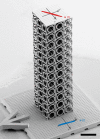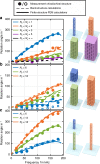Ultrasound experiments on acoustical activity in chiral mechanical metamaterials
- PMID: 31358757
- PMCID: PMC6662661
- DOI: 10.1038/s41467-019-11366-8
Ultrasound experiments on acoustical activity in chiral mechanical metamaterials
Abstract
Optical activity requires chirality and is a paradigm for chirality. Here, we present experiments on its mechanical counterpart, acoustical activity. The notion "activity" refers the rotation of the linear polarization axis of a transversely polarized (optical or mechanical) wave. The rotation angle is proportional to the propagation distance and does not depend on the orientation of the incident linear polarization. This kind of reciprocal polarization rotation is distinct from nonreciprocal Faraday rotation, which requires broken time-inversion symmetry. In our experiments, we spatiotemporally resolve the motion of three-dimensional chiral microstructured polymer metamaterials, with nanometer precision and under time-harmonic excitation at ultrasound frequencies in the range from 20 to 180 kHz. We demonstrate polarization rotations as large as 22° per unit cell. These experiments pave the road for molding the polarization and direction of elastic waves in three dimensions by micropolar mechanical metamaterials.
Conflict of interest statement
The authors declare no competing interests.
Figures




Similar articles
-
The Rise of (Chiral) 3D Mechanical Metamaterials.Materials (Basel). 2019 Oct 28;12(21):3527. doi: 10.3390/ma12213527. Materials (Basel). 2019. PMID: 31661805 Free PMC article.
-
Second-Harmonic Generation Optical Rotation Solely Attributable to Chirality in Plasmonic Metasurfaces.ACS Nano. 2018 Jun 26;12(6):5445-5451. doi: 10.1021/acsnano.8b00601. Epub 2018 Jun 7. ACS Nano. 2018. PMID: 29852066
-
New Twists of 3D Chiral Metamaterials.Adv Mater. 2019 Jun;31(26):e1807742. doi: 10.1002/adma.201807742. Epub 2019 Feb 21. Adv Mater. 2019. PMID: 30790363 Review.
-
Extrinsic optical activity in all-dielectric terahertz metamaterial.Opt Lett. 2020 Nov 15;45(22):6146-6149. doi: 10.1364/OL.403377. Opt Lett. 2020. PMID: 33186936
-
Plasmonic Chirality and Circular Dichroism in Bioassembled and Nonbiological Systems: Theoretical Background and Recent Progress.Adv Mater. 2020 Oct;32(41):e1801790. doi: 10.1002/adma.201801790. Epub 2018 Sep 9. Adv Mater. 2020. PMID: 30260543 Review.
Cited by
-
Spin-orbit interactions of transverse sound.Nat Commun. 2021 Oct 21;12(1):6125. doi: 10.1038/s41467-021-26375-9. Nat Commun. 2021. PMID: 34675212 Free PMC article.
-
Unravelling Size-Dependent and Coupled Properties in Mechanical Metamaterials: A Couple-Stress Theory Perspective.Adv Sci (Weinh). 2024 Apr;11(13):e2305113. doi: 10.1002/advs.202305113. Epub 2024 Jan 2. Adv Sci (Weinh). 2024. PMID: 38168542 Free PMC article.
-
Controllable Hierarchical Mechanical Metamaterials Guided by the Hinge Design.Materials (Basel). 2021 Feb 5;14(4):758. doi: 10.3390/ma14040758. Materials (Basel). 2021. PMID: 33562783 Free PMC article.
-
The Rise of (Chiral) 3D Mechanical Metamaterials.Materials (Basel). 2019 Oct 28;12(21):3527. doi: 10.3390/ma12213527. Materials (Basel). 2019. PMID: 31661805 Free PMC article.
-
Atomic scale displacements detected by optical image cross-correlation analysis and 3D printed marker arrays.Sci Rep. 2021 Jan 27;11(1):2304. doi: 10.1038/s41598-021-81712-8. Sci Rep. 2021. PMID: 33504911 Free PMC article.
References
-
- Kelvin TW. The second Robert Boyle lecture. J. Oxf. Univ. Jr. Sci. Club. 1894;18:25.
-
- Whyte LL. Chirality. Nature. 1957;180:513. doi: 10.1038/180513b0. - DOI
-
- Whyte LL. Chirality. Nature. 1958;182:198. doi: 10.1038/182198a0. - DOI
-
- Lindman KF. Über eine durch ein isotropes System von spiralförmigen Resonatoren erzeugte Rotationspolarisation der elektromagnetischen Wellen. Ann. Phys. 1920;63:621–644. doi: 10.1002/andp.19203682303. - DOI
-
- Lindell IV, Sihvola AH, Tretyakov SA, Viitanen AJ. Electromagnetic Waves in Chiral and Bi-Isotropic. Norwood: Media. Artech House Inc.; 1994.
Grants and funding
LinkOut - more resources
Full Text Sources

